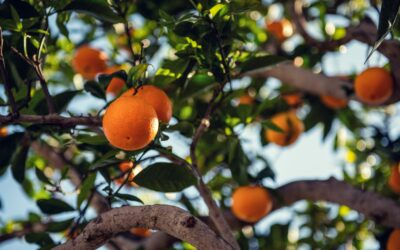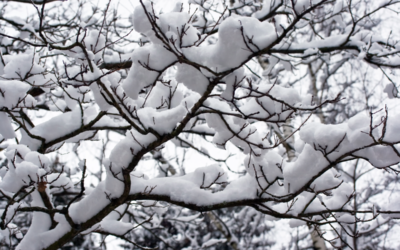While Donovan Arborist Paul Donovan has dedicated his life to the care and wellbeing of living trees, there’s one time of year that customers seek advice about trees that are no longer living: real Christmas trees.
Even before Thanksgiving 2018, the local Safeway and King Soopers were selling once-live trees at the entrances to the grocery stores. With Thanksgiving early this year, that’s five weeks in between turkey day and Christmas day…a lot of time for cut trees to dry out and become a fire hazard.
Old wives’ tales would have you think that adding floral preservatives, commercial tree preservatives, molasses, sugar, bleach, soft drinks, aspirin, and honey to the tree stand water keep the tree fresher than plain water.
No.
Nada.
Naughty.
Smithsonian.com’s Sarah Zielinski reported on a study by MythBusters in 2010 demonstrating that fertilizer, Viagra or bleach don’t make a difference. Neither does coting the entire tree with hairspray or polyurethane. MythBusters is the Australian-American science entertainment television program seen on the Discovery Channel up until 2016. The show’s purpose was to prove wrong myths people worldwide confuse with truth.
In fact, Canadian scientists reported in the journal Trees that needles fall off of Christmas trees because of ethylene, a plant hormone that ripens fruit. The researchers tried interfering with the ethylene balance in tree limbs and were able to increase the length of days the needles stayed on the branches up to 87 more days. However, the study stressed, no testing has been performed on entire trees.
(Tree huggers will be glad to know that no living trees are being sacrificed for testing.)
The danger in a dry tree is obviously fire. The National Fire Protection Association (NFPA) reported that between 2012-2016, U.S. fire departments responded to an average 170 home fires that started with Christmas trees per year. These fires caused an average of 4 deaths, 15 injuries, and $12 million in direct property damage annually.
The NFPA findings also showed:
- On average, one of every 45 reported home fires that began with a Christmas tree resulted in a death, compared to an average of one death per 139 total reported home fires.
- Electrical distribution or lighting equipment was involved in 43% of home Christmas tree fires.
- In one-quarter (27%) of the Christmas tree fires and in 80% of the deaths, some type of heat source, such as a candle or equipment, was too close to the tree.
- More than one-fifth (22%) of Christmas tree fires were intentional.
- Forty-two percent of reported home Christmas tree fires occurred in December and 33% were reported in January.
- Two of every five (40%) home Christmas tree fires started in the living room, family room, or den.
The National Institute of Standards and Technology released a video demonstrating that well-watered trees are less likely to catch fire than trees that have not been sufficiently watered. The side-by-side comparison of the two trees showed the dry tree bursting into flames in less than 10 seconds sparking a massive fire in the test home. The fire in the watered tree did not spread and remained contained.
Washington, D.C. based-NFPA reports that 40 percent of Christmas tree fires involved electrical distribution or lighting equipment and about 25 percent involved some type of heat source, such as a candle or equipment, located too close to the tree.
To help avoid a Christmas tree fire, Channel 4CBS in Washington recommended that homeowners not use string lights that have loose connections, cracked lamps or frayed cords.
Use only a single extension cord to run the distance from the home’s wall outlet to the tree. Combining more cords is problematic because they can become tangled.
Use only UL-approved lights and cords. Not all lights and cords sold to U.S. residents are Underwriters Laboratories approved. Wholesalers from China sell electrical products in the U.S. but these products are not compliant with US and EU product certification requirements.
- Turn off your holiday lighting when going to bed at night.
- Never use candles to decorate or light a tree.
- Keep your tree at least three feet away from any heat source.
- Water the tree every day.
If the water level drops below the cut end of the Xmas tree trunk a seal will form and no more water will be absorbed. Add water every day.
Media of every sort is focused on the holiday season and this year even Popular Mechanics online magazine cautions homeowners against risky tree handling practices. The Tree Care Industry Association (TCIA), a trade association of 2,300 tree care firms and affiliated companies worldwide established in 1938 as the National Arborist Association, has this important advice to people buying trees off a lot:
Make a cut across the bottom of the tree trunk, removing an inch or an inch and a half off the bottom. That's because once it is cut, the sap in the tree will start sealing over the base, and this will hinder its ability to absorb water. It only takes three hours for the bottom of a tree trunk to begin sealing over.
Get the tree in water immediately, either set it up in its stand or rest it in a bucket of water if you aren't going to put it in the stand right away.
A typical tree might absorb a quart of water for each inch of its diameter. That translates to WATER EVERY DAY. If you notice your tree is drying out, try drilling shallow holes at the tree base and refilling the tree stand with water.
As a last resort, if your tree does end up getting dried out in its stand, you can try drilling some shallow holes at the base and refilling with water.
Remember, caring for a fresh cut tree is a lot of responsibility. Perhaps this is the year to consider a living Christmas tree that can be planted in your yard (and thrive) with some advice from Paul Donovan. Call Paul at 303-623-8733. Or spare a living tree by investing in an artificial Christmas tree that you will be able to use for years to come.




